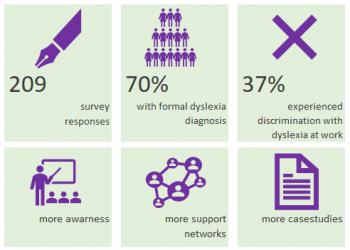Last week we devoted much of our Twitterspace to shinning a spotlight on dyslexia in archaeology. Coinciding with Dyslexia Awareness Week 2020, we posted links to resources, useful information and case studies highlighting stories of archaeologists who have dyslexia. One of our ‘zoom rooms’ during our biscuit chat on 2 October also discussed dyslexia in archaeology.
So why do this? At the end of 2019 CIfA’s Board of Directors set up a Steering Group to take forward priority areas for CIfA to lead on to address a culture change around equality and diversity practice in archaeology. One of these areas relates to personal circumstance, where CIfA can raise awareness of issues, promote existing guidance and case studies of good practice to give archaeologists a better understanding of different issues and how to address these. Anecdotally we know that there seems to be a high number of dyslexic archaeologists but in May (and in partnership with the Mentoring Womxn in Archaeology and Heritage) we started looking more at this element of our archaeological workforce.

Keen to gather new data, to identify the barriers dyslexic archaeologists face and promote ideas as to how the profession might adapt to overcome these, we developed two short questionnaires, aimed at both employers and employees. We received 209 responses which has provided invaluable data on past experiences and current challenges. The results were sobering, with 37 per cent of respondents reporting discriminative actions from co-workers and senior members of staff, highlighting that in some workplaces, outdated views that ‘dyslexic people are stupid’ persists. A summary report of the results is available on our website.
In the survey, we asked if people would be willing to provide case studies, useful links and resources that we could share during Dyslexia Week 2020. Organised by the British Dyslexia Association, this year’s theme was ‘dyslexia creates’. The survey results and cases studies certainly show the diverse and creative skills sets that dyslexic archaeologists hold – highlighting strengths in spatial awareness, problem solving, seeing different angles/scenarios with situations, excellent long-term memory, digital visualising skills, communication and more.
A common trend seems to be that many dyslexic archaeologists are diagnosed late, often at university. By this point they have developed some coping strategies to have made it this far but still face challenges and barriers with progression in their careers.
We should also consider that these are the dyslexic archaeologists who have made it this far – what about those aspiring archaeologists who haven’t been able to progress with school and make it to university but would ultimately make amazing archaeologists? Linking to other CIfA initiatives, could the development of different entry routes into the profession enable more neurodiverse archaeologists to progress? We really hope so.
Employers can play a huge part in supporting dyslexic employees. One case study last week was from Air Photo Services who highlighted that by adapting company practice (like recruitment processes) they are trying to create ‘…a working environment so that everyone plays to their strength’.
It is crucial that we share our experience with dyslexia. Sharing and hearing these stories is sobering but by opening up about our experiences, we hope that the cultural perceptions of dyslexia can change and that those who feel isolated by their unique cognitive abilities can see that they are not alone and their dyslexia is not a weakness.
As Neil Redfern from the Council for British Archaeology highlighted –‘My dyslexia does not hold me back - it drives me forward’.
You can see all the case studies on our website. A huge thank you to everyone who provided content and engaged with us on Twitter.
What’s next
Our biscuit chat highlighted that this is just the start of exploring dyslexia in archaeology. Key points that were raised included
- the need for more training for employers and employees to ensure that there is the right support in place for dyslexic colleagues
- we should be focusing on improving and enhancing the strengths of neurodiverse colleagues, rather than focusing on the perceived weaknesses
- we need more dyslexic role models in archaeology at all levels and stages of their career
- we need more discussion on this as a sector, to fully identify issues which could be resolved through enhanced understand and training
This is certainly what we aim to do in the immediate future, to facilitate more discussion, to continue to collect case studies and champion the strengths that neurodiverse colleagues bring to our workplace.
Remember – dyslexia is not a constraint, it is a superpower and one that our sector would be wise to utilise.
Go further
See more thoughts on this in the latest edition of The Archaeologist (TA 111)– ‘Dyslexia is my superpower’ (requires member login)
Check our new neurodiversity webpages on the CIfA website which has case studies and useful links
Get in touch with your stories or thoughts on dyslexia in archaeology – we would really love to hear from you.


